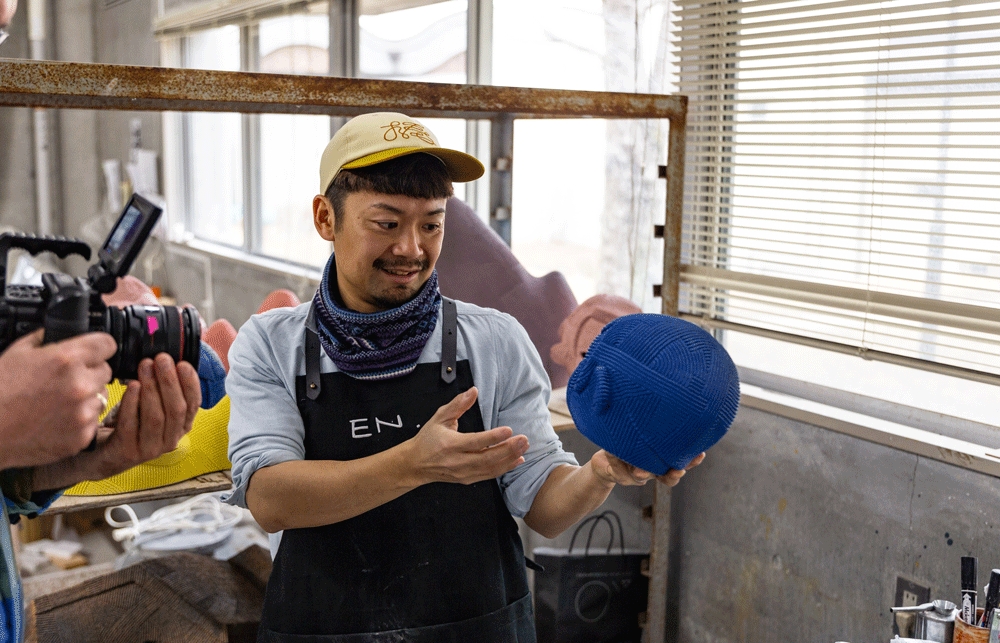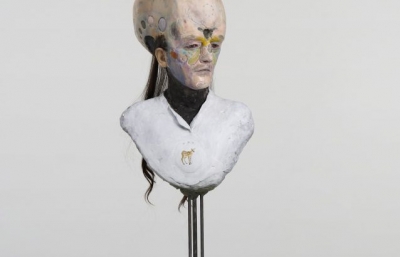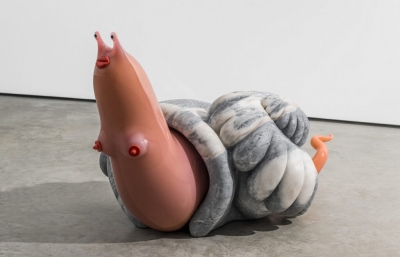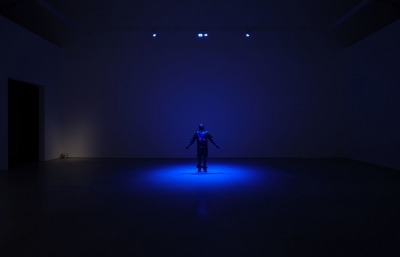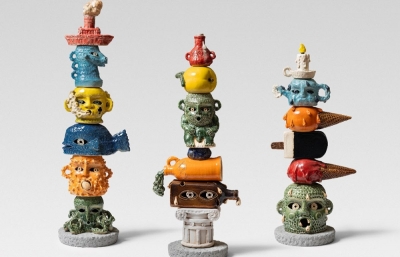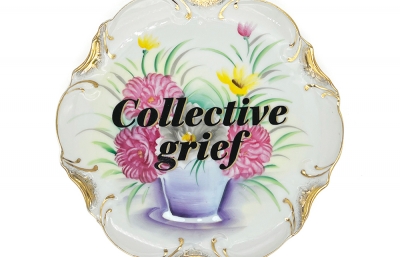En Iwamura
Encounters in Space
Interview by Charles Moore // All photography by Peter Doring
Eager to expand viewers’ appreciation for spatial experience, En Iwamura experiments with scale in his ceramic pieces. In describing his approach, the Japanese artist speaks of the fluidity of space—of distance, movement, and other vital elements that bring his stoneware clay pieces to life.
In his native country, people actively evaluate the various manifestations of Ma, an experiential concept rooted in relativity, in the search of a comfort level to foster relationships they desire with the people and places around them, a notion core to Iwamura’s multimedia approach. His work, heavily influenced by manga, anime, and traditional heroes, results in pieces that are a unique blend of history and pop culture, as he beams a dynamic trajectory. The remarkable hollow, funerary figures, widely recognized in Japan and known as Hanawa, inspire his subjects’ facial expressions, though each emanates an ambiguity that welcomes the viewer to craft their own narrative.
Born in Kyoto to artist parents, Iwamura earned his BFA at the Kanazawa College of Art and Crafts, later relocating to the United States to pursue an MFA from Clemson University, bringing his art to the international stage with the overarching goal of transcending language and cultures. There’s a sense of juxtaposition on which Iwamura relies, of the “cute,” and of the “not cute,” in his words. The artist seeks to create a sense of void, contrasting the emotional with an aura of neutrality, engaging the senses while encouraging viewers to take partake in the serious dialogue. His ceramics, colorful, varied, and entirely unexpected, are designed to create a personal encounter with the unknown, and Iwamura’s abstract paintings are no exception. In connecting with U.S. audiences, the artist has leveraged an opportunity to introduce Japanese characters to American viewers—again broaching cultural bounds. For the time being, Iwamura is happy to hone his craft, communicating with stakeholders across the global stage, and perfecting an atmospheric body of work that will undoubtedly return to gallery spaces post-pandemic.
Through his work, the artist invites viewers to take charge of their relationship with his art. As the times evolve, and with the tumult of 2020, Iwamura experiments with his own practice as well, moving from vibrant ceramic pieces to abstract paintings that reflect his signature style. His cool hues firmly exert calm, in contrast to warmer colors the artist deems “a little bit poisonous.” But this interpretation, of course, he graciously leaves to you.

Charles Moore: It seems that parental influence fostered your interest in making art. What was it like growing up with two artists in the house?
En Iwamura: My first memory of art was pretty significant because I was three years old when my younger sister was born. All my parents' attention went to her and I felt abandoned. To console me, my father gave me stacks of thin paper and a pen. He told me I should draw, and whatever I sketched, he would put up on the wall. I got his attention again—that was great for me, so I drew every night, something like 30 or 40 pieces. I was so happy they were impressed and excited about me.
It was a kind of solo exhibition, not bad for a child of three. I'm 32 now and have been having exhibitions around the world.
Tell me about your art education.
I had originally applied to study painting at university but was rejected, so I majored in ceramics for my Bachelor of Fine Arts at the Kanazawa College of Art and Craft. This is a very strong, craft-oriented school. I learned the Japanese style of the craft, which is a little different than in the U.S. For the Japanese ceramics curriculum, we learn the materials and skills first so that our creations are based on the knowledge of the materials and history of the craft.
When I did my Master of Fine Arts at Clemson University in the U.S., I found the approach was very different from Japan. Being in the U.S. for the first time, of course, I had to struggle with the language and culture, but the most shocking thing was that I was expected to conceptualize my art before I began. So, as I went about making something in clay, my professor would say, “Oh, great! You do interesting work, so what is your content?” I couldn't answer him directly because I was used to talking about techniques, or firing temperatures, or chemicals—you know, the technology of my work. But to explain what I wanted to make was extremely difficult to put into words.
But they would assure me that I didn’t need to make up the content, because the content was already in my work, though I would have to justify why I wanted to create a particular piece. I was having enough of a problem trying to communicate in my very limited English, let alone understand what on earth they were trying to get across. All the same, their line of questioning prompted me to keep thinking about my content. This made me reflect deeply about my background and personality, my cultural origins and where I am right now.

So, the work for your MFA forced you to research more about what you were making?
And why I wanted to make it, and what is the background of my creation. I will talk about that as I discuss my technique as that is easier for me.
What type of clay do you use in most of your sculptures?
I used stoneware clay, which has the greatest elasticity and is very easy to manipulate with my fingers.
Tell me more about your philosophy of art.
My philosophy is based on Ma, the Japanese concept of space. Ma implies distance, moment, space, relationship, and more. People constantly read and measure different Ma between themselves and others, and finding a comfortable Ma between people or places can produce specific relationships at a given moment. Through my work, I intend to create such an encounter and provide an opportunity for viewers to recognize the Ma themselves through entering the space.
You also have a unique technique.
My technique can be called coil building, like building a three-dimensional space with my hands. It is derived from one of the most primitive sculpting techniques called wazumi, in which mounds of coiled clay are built up to shape the figure. I do not start from any sketches—I just jump in. I roll a strip of clay over the framework into a coil, layer by layer and, as the layers form, I begin to see some lines emerging. This tells me which direction I should go.
And what influenced this style of working with the lines?
I was inspired by ancient Japanese clay objects known as Jomon pots. In fact, my technique can be called Neo-Jomon, which is one of the oldest ceramic methods where the pot is created with rope to produce the lines. I believe these lines are not particular to Japan alone but have developed out of some universal consciousness. They can be found in African Masks, Aztec ceramics, metal works, Chinese bronze, etc., to produce certain rhythms. The interesting thing is that in the process of drawing in the lines, the artist goes into a form of meditation. As I meditate while drawing those lines, I am actually putting my own story into the piece.
I believe that this style of ceramics not only crosses boundaries of space, it also reaches out into different time zones and can even communicate with future generations the same way we draw knowledge from ancient artifacts. To me, ceramics becomes a universal language which transcends space and time zones.

Let’s talk about those cute-looking figures. I’m sensing that manga and anime might have influenced your work. Were you into cartoons and comics as a kid?
Like any typical Japanese kid, I watched anime like every day, and by the time I was in junior high school, I started reading manga. My father, being a university professor, had a whole library of books on manga as a reference.
But there is more to my work than popular culture. There is a deep connection to Haniwa. You remember the terracotta soldiers unearthed from the tomb of a Chinese emperor? Those figures were also found in the history of Japan during the Kofun period. They were made for ritual use and buried with the dead as funerary objects. The same wazumi technique was used to create Haniwa, where the coiled clay was built up to shape the figures, layer by layer.
Haniwa figures have typical characteristics of neutral facial expressions, hollowed-out eyes and minimalist features. Some people think they are child-like and appealing, but, actually for me, they’re not cute because those very pieces were pulled from somebody’s grave. They look quite harmless, but they can also be scary, for those eyes are connecting two different worlds, the living and the dead.
There’s an irony here: cute but not-so-cute; simple but complex; smiling baby face but holes for the eyes that are void, emotionless. I hope that people will take my work seriously because I am attempting to find deeper spiritual connections.
For me, working on those lines can develop into an accent or hallmark for these artifacts. The lines are not just ornamental, but imply an unknown culture which I am constantly drawing on to build my own brand.
I really love your color choices in the sculptures. Do you plan the color beforehand?
Actually, I'm still exploring different materials. To be honest, all the colors are decided at the time of spraying—but this often happens by chance. I don't know which object will have which color, because, for me, I mix the clay with the glazes in different proportions for each figure, and then I spray it. Then, when I open the kiln, I am surprised every time at the colors that emerge.
When I visited Eric Parker's studio in New York, I noticed he had a huge array of colors and each had a different name. I believe that each color conveys a different meaning.
Eventually, I will develop a systematic way of producing the color range with a color chart and name each color according to its emotional content or character. The naming of the color achieves more depth.
How do you make the many interesting textures?
It's in the glaze mix. I make my own glaze. See this grainy piece? I mix clay powder with tiny particles of sand with the glaze powder, and the glaze can melt the clay to give it a shiny and somewhat melted look, but still keep its gray color.

And tell me about the type of kiln you use in your studio now.
Nowadays, since I make large pieces, I use a motor power firing method from a gas canister. An electric kiln has a certain limit on size, but the gas canister can go pretty much to any size. Still, we need a big kiln.
I fire normally at 40°C, which in the US, would be in the code 8 to 9 range, which is pretty high. The reason I started firing at a high temperature is because, when I was living in Montana, I was already making big pieces. When I didn’t have enough space in my room, I would put big square pieces outside, and they would crack because they would become frozen. So, I started to use a high firing technique to be able to put the pieces outside, without cracking.
And so now you just continue to fire at that temperature?
I can fire at a lower temperature, depending on the environment. That affects how the piece will react to temperature or snow or rain or water.
How do you deal with making large works while negotiating the size limits of the kiln? I've seen pictures of some of your really big work. How are you able to deal with making work of that size by hand?
Big has become the norm for me. I used to play sports—track and field events—so I’m a pretty fit guy. I need to use both physical strength and agility in my creations. When making large-scale pieces, including drawings, I always think about which muscles I will need to use to balance and to stretch myself.
I'm also thinking about practical things like storage and shipping…
That’s always a big problem for me. I always have to call my contacts to see where I can store the large pieces. My plan is—we'll deal with the shipping and storage when it happens.
Eventually, I have to have my own storage. Right now, I am building my studio, which occupies a very large space. But still, I don't want to keep all the work there because I want to have my works always fresh off the production line. My late teacher advised me to do the same. “Just keep making things and then let them go. Don’t store your piece because if you keep your piece in your hand, you can't grab the new things. You have to wave goodbye.”

"I am always looking for unexpected forms I have not seen before."
Right. Keep your creativity fresh. And that was actually my next question. What inspires you to create? What gives you the inspiration to create something new and different?
l have this urge to explore something new I haven't yet seen. This is a constant adventure. As I work on the clay or the coil bearings, I am always looking for unexpected forms I have not seen before. I need an encounter with unknown things, and that experience needs to be uncomfortable, uncanny, uncontrollable, where I question my thinking.
So I never get bored looking for new forms. My international travel helps a lot because I meet new people who give me new inspiration. I learned a lot from the community in Montana who were into ceramics. I like to explore the world with my work, so this is a kind of a ticket for me to get something new. The Roscoe McGarry gallery, among others, gives me the opportunity to showcase my works internationally and also gain more ideas.
It sounds like your experiences traveling, both in your home country and America, really influence the work. How does your painting connect with your ceramic sculptures?
Actually, with painting, it seems natural shifting from 3D to 2D models. My paintings are an extension of the same themes, but they’re evolving and also moving to bigger and bigger canvasses. I am also exploring the idea of working in a more abstract mode.
I understand that you have another exhibition planned for spring. What can we expect to see in your show?
What I can tell you now is that I'm going to make large bronze sculptures. I'm talking about two to three meter bronze figures. Simple color and strong lines. I want to go very simple, strong and large-scale.
Above all, I want people to see my works in the best settings, not in isolation as online photos, but also to take in the atmosphere surrounding my works. So that's why I really want to have exhibitions, where I have a backdrop in real space covering a large expanse.

